| |
|
 |
 |
| |
THE QUEST FOR THE COSTARD
Updated 2/11/22
|
If
the historical references are complete, then The Costard
(sometimes written Costarde in old references) is the second
oldest known English apple, second only to the Pearmain,
which was first recorded in 1204. The Old Pearmain and more
than one Winter Pearmain, still known, are probably not
the apple of 1204, but that is another story. The age of
the Costard makes it very special and it is unsurprising
that it has occupied many minds over the centuries. Today
it remains a compelling and vexing issue for the many who
hope to rediscover it. The quest has become something of
a mediaeval romance, where all the pleasures, adventures,
intrigues and diversions are in the ‘seeking’
and will probably never be in the ‘finding’.
The narrative is a long one, and open-ended. Such have been
the long breaks in its recorded history, such has been the
confusion between the Costard and the Catshead and so few
and inadequate have been the scant descriptions of the Costard,
that we barely know what we are looking for. |
|
| |
 |
 |
 |
| |
 |
 |
 |
| |
 |
 |
 |
| |
 |
 |
 |
| |
 |
Where does the name
come from? Almost certainly it comes from the Latin word ‘Costa’,
meaning a rib, a flank or a side. Costa has become the stem
of many more words, such as Coast in England or Côte in
France, meaning a hillside. So we have our first clue. The Costard
is ribbed or sided. An alternative suggestion for the origin
of the name comes from various references in Tudor times and
later in Shakespeare plays, such as King Lear, Richard III and
Love’s Labour’s Lost, where ‘Costard’
was used in place of a ‘Head’ and even as the name
of a character, but there are no supporting usages of the word
by others, as a ‘head’, and it must simply have
been a favourite word of writers before, during and after Shakespeare's
time, perhaps signifying something large and hard – like
a Costard. The Oxford Dictionary gives one origin for Costard
as ‘applied derisively to the head (arch) 1530’.
Alternatively and though very speculative, the origin of the
word Costard might have been associated with the word 'Cust',
which the Oxford Dictionary tells us comes from the Old English
word 'cyst' meaning 'choice' or 'excellence'.
There is always the
possibility that the Costard was originally French. George Lindley,
in ‘A Guide To The Orchard and Fruit Garden’, 1831,
though wrongly considering that Costard and Catshead were the
same (more later) noted that there was a ‘Coustard of
the Normandy Gardens'. There was also an old apple called Côtard,
known in Jersey, as a cider apple. Some years ago now, we were
in touch with Brian Phillipps and Rosemary Betts, of the Jersey
Cider Orchards Trust, who told us of this apple in their collection
and its earlier history on Jersey. More recently we have exchanged
many emails with Vincent Obbard, Seigneur of Samares Manor on
Jersey, where Vincent and wife Gillie have a wonderful botanical
garden, including several traditional fruit varieties, including
the Côtard. Vincent sent apples to us and later scions,
which we grafted for new trees here. We had the dna tested and
it was matched with Bulmers' Norman. On reflection, the apples
did appear to be very similar to Bulmer's Norman! It is possible
this apple was on Jersey before Bulmers collected cider apples
in Normandy and renamed them, though the apple does not have
much in common with the Costard we seek. It might also be the
result of an error in grafting. Either way, there does not appear
to be a different Costard on Jersey, known now. There is another
ribbed green apple, without a name, that Vincent has sent us
and which has an umatched dna. We are still observing it.
Still considering
the 'French Connection', perhaps there was French knowledge
of an English apple. In 1597 Sir Thomas Tresham wrote a document
mentioning that an apple called ‘French Custard’
was growing in Mr Dean’s garden at Ely. However, there
is no known mention of a Costard in any of the reference works
in France, through the ages, though their records have been
more extensive and often much earlier than ours. Curiously,
the word Costard does exist in French, meaning a costume or
suit.
In England, the commonly reported
first reference was in 1292 when it was mentioned as Poma Costard
in the fruiterers’ bills of Edward the First. The fruiterer
to the King bought 300 pounds of Costards to supply the entourage
when Edward stayed at Berwick Castle, during his campaign in
Scotland. Taylor, in 1946, in ‘The Apples of England’,
gives a slightly later date of 1297 - when they were sold for
a shilling per hundred at Oxford. He adds that the price of
29 Costard apple trees was 3 shillings in 1325. Teresa McLean,
in her excellent book ‘Medieval English Gardens’,
1980, has reported some interesting observations from early
authors. She said “The most popular medieval apple was the Costard,
which made good cider and good eating” and “They
were good, vigorous growers, their bark yielding a red dye,
and they were the national favourite until the 17th century”.
McLean comments upon the Earl of Lincoln, who came into the
possession of a property at Holborn, subsequently known as Lincoln’s
Inn and Lincoln’s Inn Fields, in 1286. He was a keen gardener,
having many gardens, and made a substantial income out of selling
fruit and fruit trees. She noted that he obtained apple and
pear cuttings from the Continent and that “The Costard apple arrived in England at about this
time, as did the Pearmain, used for making cider, and they were
probably both among the new breeds of apple the Earl imported.
We know for certain that he got two cuttings of the Costard”
(reference unknown). If the Costard was new from the Continent
in 1286 (the earliest date suggested) then it is hard to see
how new trees, from two cuttings, would have been capable of
generating 300 pounds of apples for Edward’s troops and
household in 1292. The solution lies with a barely known phrase
used by Robert Grosseteste, Bishop of Lincoln and also known
as Robert Greathead and Robert of Lincoln. He lived from 1175
to 1253 and spoke of 'apples and Costards'. Not only does that
place the Costard in the first, not second half of the 13th
century, possibly predating the Pearmain, but it rather implies
that the Costards were viewed as a class of fruit standing apart
from apples.
Moving forward in time, Rogers,
in the History of Agriculture and Prices (1886) has discovered
that "In the year 1345 some
fruit is called costard at Letherhead, and is sold at an exceptionally
high rate." In the 14th century, having been copied
in the 17th century, were several Anglo-Norman medicinal cures
for a wide range of ailments. One passage read
"Pur flux de ventre..tornes pur chaude meneysoun..pour
chaude meneysoun: pernez un poume costard" - For
something that runs of the belly... turn to chaude meneysoun
(the same as flux, something that runs): take a pomme costarde.
In short, for diarrhoea, dysentery or excessive menstruation,
eat a costard. The Costarde was mentioned in the ancient poem
‘The Pistel of Swete Susan’, thought to have been
written around 1390. It says "be costardes comeliche in cuppes pei cayre".
Comeliche = Comely, Cuppes = Cups and Cayre means gone or over.
We have seen it elsewhere that Chaucer (in the 14th century)
wrote "your chekes embolmed
like a mellow costard", though we do not have a
date. John Lydgate, and English monk and poet recorded before
1435 "The ffruytes which more
comvne be Quenynges, peches, costardes and wardouns"
- The fruits which more common be Queenings, Peaches, Costards
and Warden Pears. A reference from 1450 was noted in T.Austin's
'Two 15th Century Cookery Books' -
"Take Costardys, Perys, &
pare hem clene & pike out be core".Take Costards, Pears, peel them clean and decore them.
In 1519, a record from the Wardens' accounts of the 'Worshipful
Company Founders City of London' said "Gret costerd with peyores & wyn". - Great Costard with pears and wine.
This might suggest that if there was a Great Costard, there
was also a lesser one. In 1622, the poet Michael Drayton published
his 'Poly-Olbion' and included
"The Wilding, Costard and Pomwater" as he wrote of apples in Song18, p298. In 1655, T. Moffett and
C.Bennett, in Healths Improvement.... said “Some (apples) consist more
of aire then water,… others more of water then wind, as
your Costards and Pomewaters, called Hydrotica.” We then encounter various references to Costards as 'heads'
in a derogatory way. About 1515, the play Hyckescorner, by De
Worde includes
"I wyll rappe you on the costarde with my horne". In 1556 the Udall play 'Ralph Roister Doister' says "I knocke your costarde if ye
offfer to strike me".
In 1606 Shakespeare's
King Lear and also other plays by him used the word as an alternative
to 'head'. In 1723 Williams, in 'Richmond Wells' also used the
idiom as did Walter Scott in 'Rob Roy' in 1817. Perversely,
when the apple was no longer known, the use of the word as a
'head' continued, as in 1880, in Webb's translation of Goethe's
'Faust' and in 1928 in Bennett's 'Vanguard'.
Returning to Costards as apples,
a very interesting episode and exchange, between the widow of
Sir Thomas Tresham (1543-1605) of Lyveden New Bield in Northamptonshire
and Robert Cecil at Hatfield House, Hertfordshire, took place
at the start of the 17th century. The Greatt Green Custarde
was part of the narrative and will be returned to at the end
of this appraisal of the Costard. Dame Muriel Tresham donated
fruit trees to Hatfield House in 1609, probably as a 'Thank
You' to Robert Cecil for calling off her persecutors. Sir Thomas
had been a Roman Catholic and stood on the wrong side of the
times, often perilously. After his death, his widow was still
facing antipathy. In 1609 she complained of her treatment to
Cecil and offered him 50 trees 'out
of Lyveden orchard towarde the planting of the orchard which
I heare your Lordship intendeth at Hatfeyld'. A
receipt for the trees exists at Hatfield though there is no
record of whether the trees were bought or were a gift. We thank
Kate Harwood for this account and on several other matters.
Her passion and knowledge are peerless. The narrative carries
on. Kate adds another
reference - Andrew Eburne, Garden History, Vol 36 No 1 Spring
2008 page 129. Dame Muriel said 'I
think no one place can furnish your Lordship with more and better
trees, and of a fitter growth, than this ground. For my late
worthy husband, as he did take great delight, so did he come
to great experience and judgement therein' and 'I will have Catshead,
and Dr. Harveys, and French Crab for making cider … And
Great Green Costard and Winter Queening … though middling,
it will keep til Lent - As to Pears, I must have Black Worcester.
Aye. ‘tis a very excellent good pear that will last the
winter'.
|
Another interesting
connection was between Robert Cecil at Hatfield and John Tradescant
the Elder (1570-1638). Tradescant produced a list in 1634 of
the plants and trees collected by him and planted at ‘The
Ark’ at Lambeth, Surrey. In 1610/11 he was sent by Robert
Cecil to the Low Countries to collect fruit trees, though the
English names in his lists were probably collected earlier.
Tradescant died in 1638 at the age of 68, so the 1634 date of
this apple list was at the end of his life and the various fruit
trees probably existed much earlier. The document, with others,
passed to Tradescant the Younger (who did his collecting in
the Americas) and then to Elias Ashmole, finally residing in
the Bodleian Library at Oxford. Tradescant the Elder included
both 'Smelling Costard' (the only reference) and Grey Costard.
John Tradescant the Elder and John Parkinson (below) were friends
and great mutual admirers.
Returning to
the timeline of references, William Lawson in ‘A New Orchard
and Garden’, of 1597-1618, said “Of
your apple-trees you shall find a difference in the growth.
A good pippin will grow large, and a Costard Tree: stead them
on the North side of your other apples...” The
first description (albeit brief) came in 1629 when John Parkinson
published his ‘Paradisi in Sole Paradisus Terrestris’
and wrote of two different Costards! "The gray Costerd is a good great apple, somewhat
whitish on the outside, and abideth the winter’ and ‘The
greene Costerd is like the other, but greener on the outside
continually". We now have something to pursue. It
is a large apple, a vigorous tree, of quality and lasting over
the winter, but with different colours. The ‘greene Costerd’
is quite possibly the Green Custard which is still known and
is a large, green, ribbed apple, which will keep over the winter.
In 1676 the Philosohical Transactions of the Royal Society include
"All sorts of English Apples, as Pearmains, Pippins,
Russetens, Costards". In 1716, Stevenson, in 'The Young Gard'ner's Director'
wrote "The
names of the best sorts off Apples...Costards, Lordings, Pearmains,
etc.". This reinforces
the implication that the Costard is a type of apple, perhaps
in the ilk of Pippins and Pearmains, rather than a single variety,
and Lawson has told us his Costard is a tall growing tree.
|
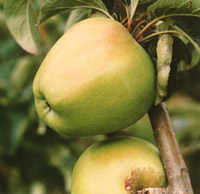
Green Custard
|
At
this point we have to address the confusion between Costard and
Catshead, which seems to have arisen early in the 19th century.
Comments upon this will punctuate our narrative, but for the moment
we only observe that Parkinson described both Catshead and Costard,
separately. From 1669 onwards, through various editions of the
‘Pomona’ attached to his ‘Sylva’, John
Evelyn wrote of both Catshead and Costard separately. In 1670,
Leonard Meager in The Compleat English Gardner’ listed three
types of Costard, ‘the White, Grey and Red’. John
Rea in his ‘Flora seu de Florum Cultura 2nd edition’
of 1676 repeats white, gray and red. John Worlidge in his ‘Vinetum
Britannicum’ of 1678 said that he had not seen it but that
‘it was in many places of esteem’. He also noted Catshead
separately, as did John Ray in his ‘Historia Plantarum Generalis’
of 1686 who wrote of the Costard-Apple, as well as ‘go-no-further
or Catshead’. Ray, who wrote in Latin, said of the Costard
“Nor should be omitted from this
catalogue that which is called 'The Costard Apple', that was once
held in such high esteem, that an apple seller, as a kind of epithet,
was known by this name. For they are still today called 'Costard-mongers'”.
We are very grateful to Bryan
Ward-Perkins and Mark Norman for their help with a difficult Latin
translation, beyond our skills.
|
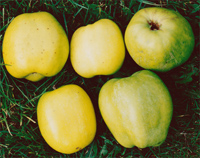
Catshead
|
|
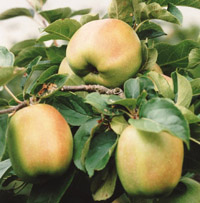
Catshead
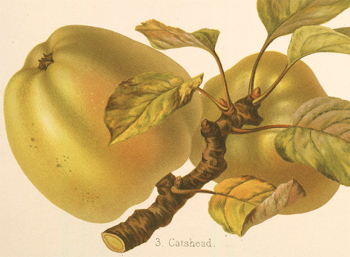
Catshead, Courtesy of Sheila Leitch, Marcher
Apple Network, from the Herefordshire Pomona
|
|
John
Mortimer in ‘The Whole Art of Husbandry’ in 1708,
repeated Worlidge’s words but added that it was ripe in
October. He also wrote of Catshead. Richard Bradley, in his Dictionarium
Botanicum of 1728 gives a list of apples "as are accounted the best for Eating and Baking
from Mr. Whitmill’s catalogue, Gardiner and Nursery Man
at Hoxton". He includes Costard Apple as well as Catshead.
If the Costard began its history
as a Class or Type of apple, it now seems to have become a 'Variety'.
We must also bear in mind that apples have a strong tendency to
mutate and shift their nature and appearance over time. If a shoot
on a tree has mutated and that shoot is used to graft another
tree, the fruit from the new tree might not look or taste quite
the same as that from its parent. Please bear this in mind as
we move onto the next point in history and a very significant
one. The old Costards might now have quite different natures and
appearances. We must also factor in the 'Little Ice Age' that
followed the 'Mediaeval Warm Period'. From 1650, ice and glaciers
expanded into the North Atlantic, affecting climate across northern
Europe, with significantly lower temperatures. This period did
not go into reverse until 1850, so all the early and middle period
writers were commenting upon ripening times and storing periods
that would not be observed after 1850 and particularly would not
be seen under global warming. Costards might be ripe in late September
or early October and might not store so well over the winter.
One of the truly great and one
of the very few authoritative writers on gardening of his age
was The Reverend William Hanbury of Church-Langton, Leicestershire.
His ‘A Complete Body of Planting and Gardening...’
in 1770, was written from real experience, rather than from repeating
the already repeated words of others. He set up plant nurseries
in his area and used the proceeds exclusively for improvements
locally - notably the Church and a new school. His descriptions
of apples could not have been written without great familiarity
with them. His varieties hark back to names known in the 17th
century or early 18th, rather than new names that were becoming
known late in the 18th century. As you might have guessed, he
included the Costard! It “Is a large, irregular Apple, finely striped with red, especially
on the sunny side. The flesh is tender and juicy, but not very
agreeable to the palate. This Apple is in universal request for
baking, and affords the best sauce yet known for a goose, roast
pork, and the like savoury meats.” This is the first
reference to a striped apple - perhaps now mutated. The description
takes us further.
Richard Weston, in ‘The
Gardener’s and Planter’s Calendar’ of 1773,
said the Costard was ripe in December. In 1778, Thomas Mawe and
John Abercrombie, in ‘The Universal Gardener and Botanist’,
said of the Costard Apple "large,
irregular and red striped" and just two lines lower
said "Cat’s-head Apple, very
large, for culinary uses".
We know a little
more. ‘A’ Costard is ripe between October and December,
and will last longer, is large, irregular and red striped. Both
Costard and Catshead were included in ‘A Brief Catalogue
of Fruit Trees, sold by William Pinkerton, Nursery and Seedsman,
in Wigan, Lancashire, 1782’. The list included 121 varieties
of apple. In 1786 the 'Gentleman's Magazine' recorded "Upon the Costard I grafted the Broadin or Garden Apple".
William Forsyth in ‘A Treatise on the Culture and Management
of Fruit Trees’ in editions up to 1810 listed Costard and
Catshead. The Costard still appeared to exist and be known into
the 19th century, but then a pomological disaster struck.
In the first
collection catalogue of the London Horticultural Society of 1826
no Costard was listed but there were two Catsheads – ‘Catshead’
and ‘Round Catshead’. The latter was given a synonym
of Téte du Chat (of Jersey). This was also the case in the 1831 edition, but the 1842 edition
now listed Costard saying ‘see Catshead’ and Costard
(and Coustard) were given as synonyms of Catshead, under that
entry. It still included Round Catshead separately. Catshead was
described as being pale green, oblong, large, for kitchen use,
top quality and ripe from October to January. Round Catshead was
described as yellow, roundish, large, for kitchen use and ripe
from December to March. The timing of this allocation coincides
with the entry under Catshead by George Lindley, in ‘A Guide
to The Orchard and Fruit Garden’ in 1831. Lindley was the most influential authority and writer
of the time. Though otherwise meticulous in his research and precision,
he made a terrible mistake. He said that Catshead was the same
as the Costard of Ray (1688) and for no reason that can be fathomed.
Ray had noted both separately as did so many other earlier writers.
The ‘synonym-isation’ of Costard led to ‘no
further enquiry’ and to its decline, as well as to an increasing
plurality of various Catsheads, under the confusion.
|
In
the 1843 catalogue of John and Charles Lee, nurserymen of Hammersmith,
London, There was a reversal of names in that they listed
Catshead (in use from October to January) and Catshead Round
(in use from December to March) and they gave Costard as a synonym
of Catshead Round, not to Catshead. This nursery, as 'Lee and
Kennedy', had been going since the first half of the 18th century
and would have been familiar with Catsheads and Costards. Perhaps
they chose to correct the London Horticultural Society. Either
way, the nursery trades were now selling two types of Catshead
and no Costards under that name. Perhaps old Costard trees can
still be found in London, though the nurseries of Lee and Son, have long
gone, to houses and offices.
The
next observations on the Costard came with the publication
of ‘British Pomology’ by Dr Robert Hogg, in 1851.
He was manifestly describing apples from sight, as the references
he gave for the entry under Costard gave no detail on the
apple for him to repeat. Whether it was the right apple is
less than clear, as subsequent descriptions by him were different.
The entry in British Pomology reads “Above medium size, two inches and three quarters,
or three inches wide, and three inches and a quarter high;
oblong, but narrowing a little towards the eye, distinctly
five-sided, having five prominent ribs on the sides, which
extend into the basin of the eye, and form ridges round the
crown. Skin, smooth, dull yellowish green, strewed all over
with embedded grey specks. Eye, partially closed with long
acuminate segments, and set in a rather deep and angular basin.
Stalk, about a quarter of an inch long, inserted in a round,
rather shallow, and narrow cavity. Flesh, greenish-white,
tender, juicy, and with a brisk, and pleasant sub-acid flavour.
An excellent culinary apple of first-rate quality. It is in
season from October to Christmas. The tree is hardy, a strong
and vigorous grower, with strong downy shoots, and an abundant
bearer.” He adds that “The
true Costard is now rarely to be met with.” While
Hogg says the Costard will go to Christmas, Parkinson had
said that it “abideth the winter.”
In 1872, the
famed nurseryman of Merriott, in Somerset, John Scott, published his ‘The Orchardist’
and though, frustratingly, he failed to give a full description
of the Costard, he had some interesting observations to make
– and, clearly, from personal knowledge. He described
Costard as being large, of top quality, for the kitchen and
lasting till April. “Long and somewhat square, or 5-angled or ribbed,
from which it has evidently deserved its Latinised name, i.e.,
Costa, a rib; one of our oldest English Apples and is one of
our best kitchen fruit. Tree very hardy, and a great bearer;
it is of low spreading growth, and produces its fruit abundantly
as far north as Breadalbane in Scotland, where I have seen it
bear heavy crops; it there bears the name of Catshead, as it
does in many other places, although wrongly.” He
also describes the Catshead, in detail, separately, while noting
the confusion that exists between Costard and Catshead. He says
of Hogg’s description of Catshead “there
appears to me to be a little confusion in the description which
Dr Hogg has given of this fruit in his pomology. The description
seems to belong to two different sorts of apple, viz., the Costard
and Catshead. The first is always, here, oblong and five-sided,
but the second always of an irregular roundish form, and is
grown plentifully in this neighbourhood, as is also the Costard.
The Doctor says—‘Fruit large, three and a quarter
inches broad and same in height; oblong.’ This cannot
be ‘the Cat’s Head’s weighty orb’ but
would do for the Costard. The two fruits are often confounded
by writers, yet are very distinct.” Scott’s
description of Catshead was of a large apple of top quality “as a cooking Apple, November to February. Fruit
very large, round and irregular in outline; skin smooth and
unctuous, fine pale green, which becomes very light greenish
yellow at maturity, with a brownish tinge on the sunny side,
strewn with minute dots; Stalk short, inserted in a shallow
irregular angled cavity; eye large and open, set in an irregular
angled deep basin; flesh tender and sweet; juice plentiful,
pleasantly acid, and perfumed. A very old and useful Apple for
dumplings.” (Though much
of this was borrowed from Hogg).
|
The
Costard still existed as late as 1887 when the Cheshire Observer
said "Messrs James Dickson and Sons have an unsurpassed
collection of Apples: Waltham Abbey Seedling, Costard Apple,
Reinette du Canada."
After
this point, the quest becomes very murky. Perversely, the descriptions
are fuller and they have been taken in modern times as the yardsticks
against which to identify the Costard, but the evidence is flawed.
We must address the accounts of the ‘Herefordshire Pomona’
and the fifth edition of ‘The Fruit Manual’. The
former was written between 1876 and 1885, by Dr Hogg and Dr
Bull, and the latter was published in 1884 and written only
by Dr Hogg. There does not appear to be any record to confirm
which of Hogg’s writings were completed first. The stark
revelation is that the descriptions in these major works are
inconsistent with each other and also inconsistent with Hogg’s
‘British Pomology’, 1851.
|
|
The
1884 ‘Fruit Manual’, under Costard, starts
describing the features of Catshead, saying the Costard
is “no doubt synonymous
with the Catshead and this accounts for George Lindley
saying they are the same variety.” He then
qualifies the situation and in the same description he
says “Modern authors make
the Costard synonymous with the Catshead, chiefly, I think,
on the authority of Mr George Lindley, who has it so in
the ‘Guide to the Orchard’; but this is evidently
an error. All the early authors who mention both varieties
regard them as distinct.” He points out that
there are two other varieties of Costard which “are
undoubtedly distinct” namely the Herefordshire Costard
and the Gloucestershire Costard. He describes them separately.
Neither is quite the description he offers of Costard
in British Pomology of 1851. Of Herefordshire Costard
he says “Fruit, large,
three inches and a half wide at the base, and four inches
high; conical, larger on one side of the axis than the
other; towards the apex there is a waist, from which it
narrows abruptly to the eye, where it is much ridged;
it has prominent ribs and an undulating outline. Skin,
fine deep yellow on the shaded side, and bright red on
the side exposed to the sun, where it is streaked with
red and orange. Eye, small, set in a deep narrow basin,
with erect convergent segments, half open. Stamens, median;
tube, long, funnel-shaped. Stalk, about half an inch long,
stout, inserted in a very deep and prominently ribbed
cavity, sometimes with a swelling on one side of it, which
presses it in an oblique direction. Flesh, white, very
tender, with a mild sub-acid flavour. Cells, long and
narrow, pointed, ovate; axile, open. A very handsome apple,
much esteemed for roasting, and especially for baking;
in use from November till January.” He received
this apple from Dr Henry Bull, the original tree not being
a large one (at about 50 years old in 1884) and having
generally been a shy bearer. Of Gloucestershire Costard
he says “Fruit, very large, three inches wide, and three
inches and a half high; conical or somewhat cylindrical,
prominently ribbed, and with ridges round the eye; it
is longer conical than the Herefordshire Costard. Skin,
almost entirely covered with crimson streaks, mottled
with the yellow ground colour which shows between the
streaks; on the side which is shaded there is less crimson,
but more of the rich deep yellow; the surface is strewed
with minute dots. Eye, closed, with long segments, set
in a narrow, pretty deep, and plaited basin. Stamens,
basal; Tube, conical. Stalk, half an inch long, stout
and deeply set in an irregular furrowed basin. Flesh,
yellow, tender, sweet, and of good flavour. Cells, large,
open, but not wide open like the Codlins, as might be
expected from the appearance of the fruit; elliptical;
axile. This is a very handsome apple, of good flavour;
but more adapted for cooking than the dessert. It keeps
well till January.” He was describing a particular
fruit, received via Dr. Henry Bull. |
|
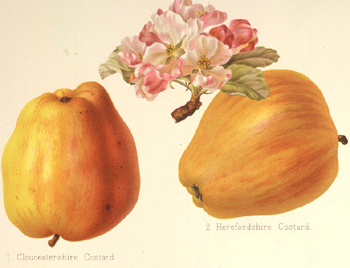
Gloucestershire and Herefordshire Costards,
Courtesy of Sheila Leitch, Marcher Apple Network,
from the Herefordshire Pomona |
The
bombshell is that these descriptions were allocated
to different names in the Herefordshire Pomona, such
that the Herefordshire Costard in the Herefordshire
Pomona carried the description of the Gloucestershire
Costard in the Fruit Manual and Vice Versa. The descriptions
were not identical but enough phrases were repeated
to be confident that some significant error occurred
between the publications of the two works. The Herefordshire
Pomona included coloured plates of the two apples, which
seem consistent with the text attached, but the error
makes both publications untrustworthy. The Herefordshire
Pomona also misquotes Parkinson (1629) saying that the
Costard ‘abideth not
the winter’, whereas Parkinson said it
‘abideth the winter’.
Hogg’s Fruit Manual did not make this mistake
and quoted correctly.
We
have two descriptions that cannot be attached with any
confidence to two names, besides which, neither appears
to accord well with the brief descriptions of the Costards
that were made in centuries before.
|
| The
trail of the Costard was rather cold by 1883, when the Royal
Horticultural Society held its National Apple Congress at
Chiswick. Two different Costards and two different Catsheads
were exhibited and described by Barron, the author of the
report of the Congress. One Costard was exhibited by Cranston
Nursery of Hereford and was described as being very large,
oblong, green, soft, early season and a fine culinary apple.
The other was exhibited by Messrs J. Jefferies and Son of
Cirencester, Gloucestershire, being described as small,
culinary, conical, tapering, angular, yellow, streaked,
acid, mid-season and of third quality. By virtue of season
or size, neither could be the true Costard. After the subsequent
RHS exhibition of 1888, the report included an appraisal
of apples suited to growing in Lincolnshire, as selected by Mr Johnson, Mr Picker and Rowson
Bros. Nursery. Both Catshead and Costard were included,
so perhaps Lincolnshire might still have the Costard growing, if anonymously. |
|
The
20th century held no reliable sightings. Taylor, in ‘The Apples Of England’, 1946,
said that by the end of the 17th century it was fast disappearing
(though there is no evidence to suggest it was disappearing
so early). He added that “the
apples exhibited at shows as Costard are usually other
old varieties.” This statement allows that
not all were other varieties. It is hard to know how he
could be certain that a true Costard was not among them.
He had “not been able to find in England a tree of the Costard” and surmised that “This
historic apple seems to have disappeared.”
Nurseries still offered Costards but Taylor was probably right and that they were other old
varieties. Towards the end of the century and into the
21st the hunt resumed and over-enthusiastic ‘identifiers’
discovered and named several ‘costards’ to
add to the multitude coming out of the 19th century. We
now have, apart from several apples simply named Costard,
the following names - Cornish Costard, Crimson Costard,
Coustard, Custard, Custard Apple, Custard Scarlet, Downway
Costard, French Custard, Gloucestershire Costard, Green
Custard, Greene Costerd, Gray Costerd, Herefordshire Costard,
Martin’s Custard, Pope’s Scarlet Costard,
Red Costard, Red Custard, Royal Costard, Scarlet Costard,
Summer Costard, White Costard, White Custard, White-Costard
Gray, Wotton Costard and more added yearly. We might also
add in apples called ‘costing’ or ‘costin’,
such as Summer Costing and White Costin, which might be
corruptions of Costard. Most of these are not now known,
their names not being attached to living examples.
If
we take the view (as we do) that apple trees can live
much longer than commonly supposed and that, in times
past, local owners would have grafted new trees for their
own use, to replace their ancient ones, and would have
passed grafts around, then true Costards are probably
still growing as old anonymous trees, of which there is
a very considerable number. The concern, in the modern
age, is that they are often carelessly and incorrectly
awarded the wrong name. The ongoing confusion with Catshead,
started by Lindley (1831) and noted by Hogg and Scott,
has now resulted in a disastrous number of different apples
being identified as Catshead, purely on the basis of being
large, green and ribbed. Some might be Costards. We have
observed, over the years, that some apples which are not
Catshead have been exhibited as such. They are large,
green, ribbed, oblong, often with a waist, late season
and keeping over the winter. The apple we have named as
Wotton Costard is strikingly similar to several sightings
of these non-Catsheads, almost all encountered in the
western counties. Given Scott’s observations on
this regular misnaming, considered above, we wonder if
they might just be the true Costard. It is only a ‘might’. |
|
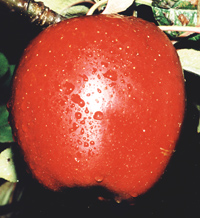
Costard (Howlett)
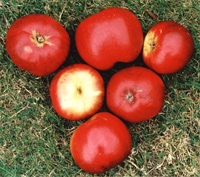
Pope's Scarlet Costard
|
| What
do we really know of the Costard? Not enough!
1. If, in the 13th century
it was a single variety, then it became two, early in
the 17th century and then three, later that century. It
might have been a class of apple, like the Pippin or the
Pearmain.
2. If we assume that
the old Greene Costerd still exists as the extant Green
Custard then we have a shape, form and character to go
on.
3. If we believe that
really old varieties still exist as living old trees,
replicated over the centuries, we can have faith that
the old Costards still exist, albeit without their names.
4. If we take Scott at
his word, we know that Costards are not as big or rounded
as Catsheads and are green, oblong, five sided and late
season keeping apples.
5. If we allow the hypothesis
that Costards are a ‘type’ of apple we might
still find the Herefordshire and Gloucestershire Costards,
noted by Hogg and Bull, which are still close enough in
time for trees to exist. Unfortunately, the confusion
with their descriptions will make it difficult.
|
Of the various apples
purporting to be Costards, most can be dismissed. There
is a Herefordshire Costard, known and grown in places
in Herefordshire, which is a green-yellow ribbed apple
and not the red coloured one of Hogg. The Costard Apple
of Hereford which is held at Wisley might be the same.
Hatfield House have two Costard trees that were planted
in the 1970s from trees supplied by the original Keepers
Nursery (the apple being different from the Costard
being supplied by the current Keepers Nursery). The
Hatfield Costard appeared very close to the coloured
Herefordshire (or Gloucestershire) Costard of Hogg,
but a recent DNA test showed it to be the same as Pope’s
Scarlet Costard – an apple bred in the early 20th
century. The appearance seemed very different between
the two, but it just goes to show how deceptive apples
can be. It seems probable that Pope’s Scarlet
Costard has turned up in several places as just ‘Costard’.
The Costard now sold by Keepers Nursery shows a green
apple and is probably Catshead. The old Keepers Nursery
supplied Cressing Temple Barns (Essex) with a Green
Costard and a Red Costard about 25 years ago and Rebecca
Ashbey, the horticulturist there, provided us with scions
to graft here. A recent DNA profile test showed that
the Green Costard was Catshead and the Red Costard was
Pope's Scarlet Costard. We also have the Costard form
Berrington Hall, Herefordshire, and that turned out
to be the same as Scotch Bridget, after profiling. There
is also a Crimson Costard known to the Marcher Apple
Network in Herefordshire, though we have not seen it,
or know of the provenance of its naming. We also have
to consider a set of apples, very similar, if not the
same, named Catshead in the western counties but which
are wrongly named. The ancient Wotton Costard is also
very similar in appearance to these. It is hard to have
faith in other contenders, read on! All those brought
into the National Collection at Brogdale, under the
name Costard, have been found to be wrong. Their Costard
(Supposed) and Costard (Howlett) are both Pope’s
Scarlet Costard. However, we now have two more candidates,
(possibly three) that have emerged since we first wrote
this appraisal. We consider these at the end.
We wrote before - "In
conclusion, frustrating as it is, and dispiriting not
to be able to find such an ancient apple, we must accept
that re-connecting the name to some old tree (which
will still exist) cannot be done with certainty. It
has been our compelling experience that the more an
apple is described, the greater are the inconsistencies
and the greater the confusion. We just don’t have
enough reliable information to go on. Perhaps there
will be some old document, buried in some archive, that
will unlock the mystery. For those of us who savour
mystery and who place 'The Quest' above its resolution,
there will be a perverse hope that the Costard will
never be found. To look at an apple from some ancient
tree and say ‘I wonder if….’ is the
greater pleasure. Regardless, the quest will go on."
We previously updated
this account in January 2021, with some important additions
and we again thank Dr Theresa Tyers, of Loughborough
and at Swansea University, for notifying us of many early references to
the apple, drawing upon her expertise in mediaeval medicines
and their social history as well as her knowledge of
early literature. Her input greatly augmented the narrative
in that update. Now, in November 2022, we have made
further amendments and can finish with some thoughts
on two recently researched apples that have shown on
our radar and have some claim to be missing Costards.
They are different apples, each unmatched in their dna
with other known apples.
|
|
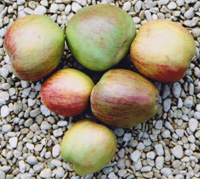
Hatfield Costard
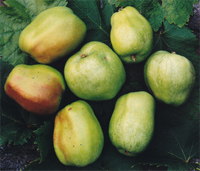
Wotton Costard
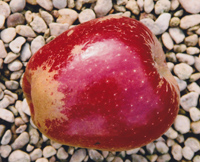
Red Costard |
|
|
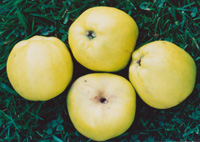
Herefordshire Costard (Wisley) |
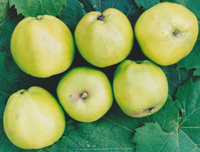
Costard
(Berrington Hall) |
|
The
Lightning Tree/Suzie's Costard
Dr
Suzie Imber is a planetary astrophysicist at Leicester
University, a good friend (as are her parents) and a
human dynamo. While living at East Langton, Leicestershire,
she bought a very old orchard nearby, to ensure its
future as an orchard and for the pleasure of tending
it. For those readers who have been paying attention,
it will not be lost on them that we earlier talked about
the Rev. William Hanbury at Church Langton. There is
also a West Langton. The name Langton comes from Old
English - Lang, meaning Long, and Tun or Ton, meaning
a farm settlement. The area is of great antiquity. Suzie
and her parents called on us to ask what we could tell
them about the variety of apples they brought, a few
years back. We then spent a fascinating day visiting
Suzie, the area and calling in on her friend Mark Newton,
who now owns Hanbury's rectory at Church Langton, and
is man of great local knowledge. The Rev. William Hanbury,
as we detailed above, set up several plant and fruit
tree nurseries around the Langtons in the mid 18th century.
Suzie's very old trees were likely to have come from
the Hanbury pool. Could one be a Costard, as described
by Hanbury? One, called the Lightning Tree could fit
the bill. Before a lightning strike the tree was around
50ft tall, but is now around 35ft. It is of spreading
habit, as in Scott's description, but hardly low, as
he says. Perhaps he was looking at younger trees. William
Lawson in ‘A New Orchard and Garden’, of
1597-1618, said “Of your
apple-trees you shall find a difference in the growth.
A good pippin will grow large, and a Costard Tree:..."
|
|
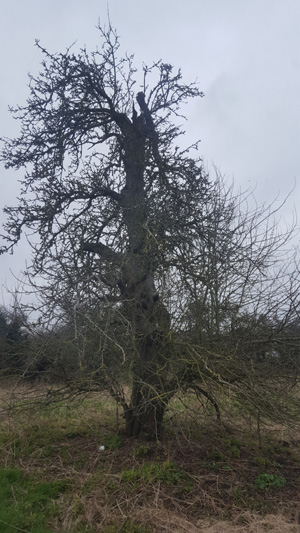
The
Lightning Tree/Suzie's Costard |
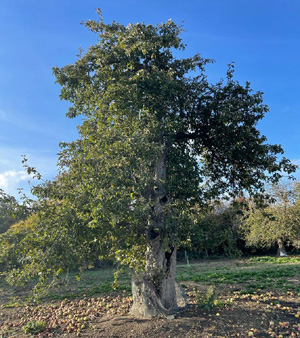
The Lightning Tree/Suzie's Costard |
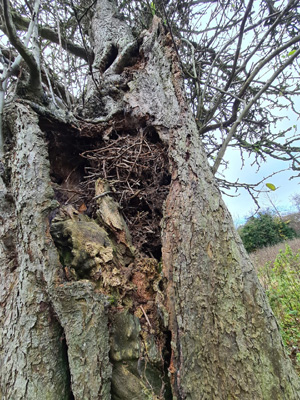
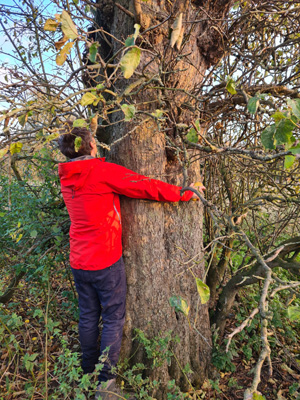
The Lightning Tree/Suzie's Costard
|
This is a
truly old tree and its DNA has not been matched with
any other tested tree. Other trees in the orchard have
found matches but not of middle aged or newer varieties.
The whole orchard is old. But what of the apples, shown
below? Hanbury's description of the Costard, repeated
here to save you time finding it above, said it “Is a large, irregular Apple, finely striped with red, especially
on the sunny side. The flesh is tender and juicy, but
not very agreeable to the palate. This Apple is in universal
request for baking, and affords the best sauce yet known
for a goose, roast pork, and the like savoury meats.”
That description fits this apple prefectly (though caution
says it could fit others). We would say that the apple
is pleasant enough to eat raw, when fully ripe, but
otherwise the fit is complete. From fruit received in
mid November 2021 (a more reliable year than fruit from
the hot and dry year of 2022) our notes were thus. The
flesh is cream to pale green, green along the core line.
It slowly discolours when cut, but not so much as some.
The apple is fairly weighty and the flesh is not over
juicy, of an open texture, firm rather than crisp. Pleasantly
sweet and with a fair flavour, a little of lemon. Fine
to eat but not the best. Cooked, it softens very quickly
and goes to a mashable puree consistency. The flavour
is very much enhanced and it has all the right elements,
perfectly balanced. The flavour is quite complex, and
very good indeed. Very rich and no need for added sugar.
The flesh has gone yellow after cooking. At the end
of January 2022 we noted that the apple was still solid
but the flesh inside had now gone a little tough. The
flesh was firm, not soft and moist enough. The flavour
was good, not sharp and was a reasonable eater. It cooked
fairly quickly and broke down. The flavour was pretty
good but maybe not as good as before in the autumn.
Sweet enough without sugar and rich enough but maybe
the quality had faded a bit. In any one year, especially
in warmer years, it is enough that this apple lasted
to the end of January.
This apple
- Suzie's Costard - has a legitimate
claim to be the Costard of Hanbury or the ancient Costard
if these are the same! It might be the Costard of Parkinson,
if that had undergone some mutation to introduce stripes,
but the Gray and the Greene Costards of Parkinson might
have other claimants.
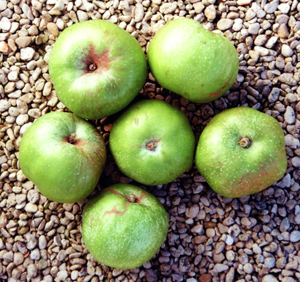
Apples Late September 2022
|
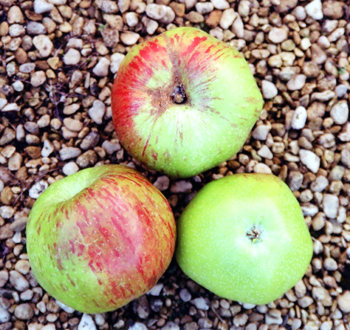 Apples
Mid-October 2022 Apples
Mid-October 2022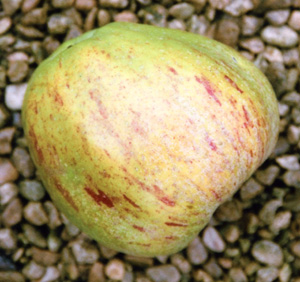
Apple November 2021
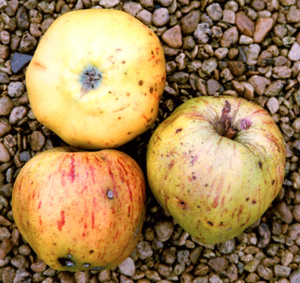
Apples Mid November 2021 |
The
Sawmill Costard(s)
As
we noted much earlier in this article, the Costard existed
with Sir Thomas Tresham at
Lyveden New Bield in Northamptonshire in the
late 16th century. His wife, Dame Muriel, after his
death, donated Costards to Robert Cecil at Hatfield
House in Hertfordshire in 1609. John Tradescant the
Elder, a friend and collaborator of Robert Cecil, was
also familiar with the Costard. Peter Oakenfull, Ecologist
and 'Apple Hunter' - a friend of ours - had a personal
communication from a former head gardener to The Dowager
Lady Salisbury that this and other trees supplied by
Lady Tresham, were planted in the walled Vineyard at
Hatfield. Though some ageing apple trees are still in
the Vineyard garden, no truly ancient apple trees still
exist in this very large walled garden and none that
could be considered Costards.
In
an orchard at the Old Sawmill at Hatfield there are
two apples which could fit the 'Costard' brief. Peter
says 'the Vineyard is around 200m from Sawmill but there
were other orchards towards Sawmill... generically they
would have most likely been considered as being in the
Vineyard area though'.
Could they have come from a decrepit Tresham tree in
the Vineyard, making their was from sequential graftings,
to the Sawmill? There are two trees there which bear
large, ribbed, green apples, late in season and lasting
into the New Year. Both are cooking apples that can
be eaten raw at full maturity in November. One is very
old and the other was seemingly planted in the first
part of the 20th century, though accurate estimates
of apple tree age are very difficult to make. Apple
trees are full of surprises. It might be that this younger
tree was grafted from a much older tree that was failing
in the same orchard. Being young does not signify that
the variety is young. Both trees have DNA unmatched
with all others that have been tested and each is different
to the other as regards DNA.
We
call them 'Sawmill Old Costard' and 'Sawmill Young Costard'
for the time being, though Peter has favoured
'The Hatfield Costard' for the older one.
|
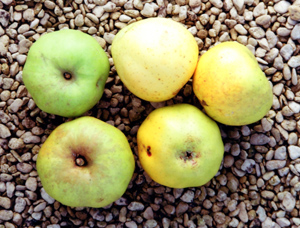
Sawmill Old Costard Mid October 2022
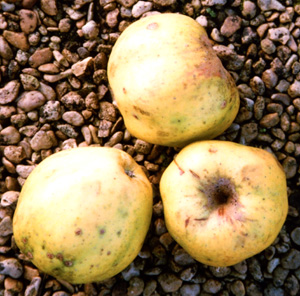
Sawmill Old Costard November 2020 |
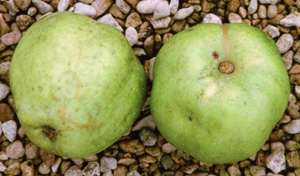
Sawmill Young Costard October 2020
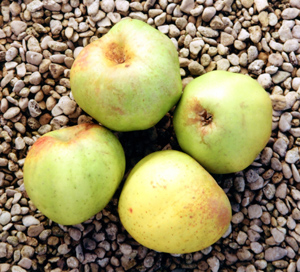
Sawmill Young Costard Mid October 2022 |
|
|
|
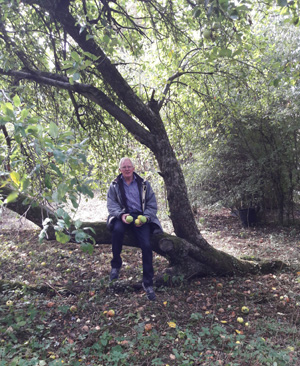
|
A Visitor
to the Old Costard, before damage and pruning.
|
|
This orchard
was rather overgrown in 2020, with many parts in deep
shade, so it was not easy to make definitive judgements
on the quality of the fruit at that time, but both apples
were pleasant to eat and cooked well, breaking up, and
became very rich. Over the winter of 2020/21 the Hatfield
Estate pruned some boundary ashes and a Lawson Cypress,
which caused the loss of a major bough of the Old Costard,
but the tree is safe and continues to fruit. Peter has
provided apple samples and contributed greatly to the
painstaking extraction of the facts around the case.He
is waiting (as at early November) to gather further
samples from both trees at the peak of ripeness and
to observe the keeping qualities into the new year.
Our thanks go to him for his energy, enthusiasm and
efforts in all things pomological.
There is
more to be written, but as we stand we have some possibilities
of rediscovery of old Costards, albeit we are still
inclined to believe that Costards were a class of apples
rather than single varieties. There is another contender
that we have not yet discussed. This is another apple
very close to The Rev. William Hanbury's patch, but
that is for another day. Other distinct, green, ribbed,
large, dual purpose apples, ripe late in the year and
storing, are out there. We might still never know the
true Costard(s) but the search has its own rewards -
in discovering ever more truly interesting and long
forgotten varieties.
Updated 2/11/2022
|
|
|
|
|
|